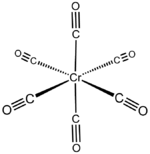This is an old revision of this page, as edited by CheMoBot (talk | contribs) at 03:41, 25 January 2012 (Updating {{chembox}} (no changed fields - added verified revid - updated 'DrugBank_Ref', 'UNII_Ref', 'ChEMBL_Ref', 'KEGG_Ref') per Chem/Drugbox validation (report errors or [[user talk:CheM...). The present address (URL) is a permanent link to this revision, which may differ significantly from the current revision.
Revision as of 03:41, 25 January 2012 by CheMoBot (talk | contribs) (Updating {{chembox}} (no changed fields - added verified revid - updated 'DrugBank_Ref', 'UNII_Ref', 'ChEMBL_Ref', 'KEGG_Ref') per Chem/Drugbox validation (report errors or [[user talk:CheM...)(diff) ← Previous revision | Latest revision (diff) | Newer revision → (diff)
| |
| Names | |
|---|---|
| IUPAC name Hexacarbonylchromium | |
| Other names Chromium carbonyl | |
| Identifiers | |
| CAS Number | |
| 3D model (JSmol) | |
| ChEBI | |
| ChemSpider | |
| ECHA InfoCard | 100.032.579 |
| PubChem CID | |
| RTECS number |
|
| CompTox Dashboard (EPA) | |
InChI
| |
SMILES
| |
| Properties | |
| Chemical formula | C6CrO6 |
| Molar mass | 220.057 g/mol |
| Appearance | colorless crystals |
| Density | 1.77 g/cm, solid |
| Melting point | 150 °C |
| Boiling point | 210 °C (decomp) |
| Solubility in water | insoluble |
| Solubility | soluble in ether, chloroform, tetrahydropyran (THP), methylene chloride |
| Structure | |
| Crystal structure | orthrhombic |
| Coordination geometry | octahedral |
| Dipole moment | 0 D |
| Hazards | |
| Occupational safety and health (OHS/OSH): | |
| Main hazards | Toxic |
| NFPA 704 (fire diamond) |
 |
| Flash point | 210 °C |
| Lethal dose or concentration (LD, LC): | |
| LD50 (median dose) | 150 mg/kg (oral, mouse) 230 mg/kg (oral, rat) |
| Related compounds | |
| Other cations | Molybdenum hexacarbonyl Tungsten hexacarbonyl |
| Except where otherwise noted, data are given for materials in their standard state (at 25 °C , 100 kPa).
| |
Chromium carbonyl, also known as chromium hexacarbonyl, is the chemical compound with the formula Cr(CO)6. At room temperature the solid is stable to air, although it does have a high vapor pressure and sublimes readily. Cr(CO)6 is zerovalent, meaning that Cr has a formal charge of zero, and it is called a homoleptic complex, which means that all the ligands are the same. The complex is octahedral with Cr-C and C-O distances of 1.91 and 1.14 Å, respectively.
Reactions
When heated or photolyzed in tetrahydrofuran (THF) solution, Cr(CO)6 converts to Cr(CO)5(THF) with loss of one CO ligand. Similarly, heating a solution of Cr(CO)6 in an aromatic solvent results in replacement of three CO ligands:
- Cr(CO)6 + C6H5R → Cr(CO)3(C6H5R) + 3 CO
Such reactions proceed particularly well with electron-rich arenes such as anisole, either as the neat reagent or using a mixture of THF and dibutyl ether, the latter to increase the boiling point of the mixture. The products adopt a "piano-stool" structure. These species are typically yellow solids, which dissolve well in common organic solvents. The arene can be liberated from the chromium with iodine or by photolysis in air. In general, substituted derivatives of Cr(CO)6 decompose upon exposure to air.
Alkyl and aryl organolithium reagents RLi add to a carbonyl ligand to give anionic acyl complexes. These species react with alkylating agents such as Me3O to form (OC)5Cr=C(OMe)R, an example of a Fischer carbene. If the R group is a vinyl or an aryl group, then the resulting carbene complex can react with an acetylene to form a new benzene ring to which is bonded the chromium tricarbonyl fragment. The two acetylene carbon atoms become part of the new ring, as does a carbon from one of the carbonyl ligands. Also the three carbons from the vinyl carbene become part of the new benzene ring.
Safety
In common with many of the other homoleptic metal carbonyls (e.g. nickel carbonyl and iron carbonyl), chromium hexacarbonyl is toxic and thought to be carcinogenic. Its vapor pressure is relatively high for a metal complex, 1 mm Hg ( 36 °C).
References
- Whitaker A.; Jeffery, J. W. “The Crystal Structure of Chromium Hexacarbonyl” Acta Crystallographica 1967, volume 23, pp. 977-984. doi:10.1107/S0365110X67004153.
- Elschenbroich, C. ”Organometallics” (2006) Wiley-VCH: Weinheim. ISBN 978-3-29390-6
- Patnaik, Pradyot (2003). "Chromium hexacarbonyl". Handbook of Inorganic Chemicals. McGraw-Hill Professional. pp. 222–223. ISBN 9780070494398.
External links
| Chromium compounds | |||
|---|---|---|---|
| Chromium(0) |
| ||
| Chromium(I) |
| ||
| Chromium(II) |
| ||
| Chromium(II, III) | |||
| Chromium(III) | |||
| Chromium(IV) | |||
| Chromium(V) | |||
| Chromium(VI) |
| ||
| Polyatomic ion | |||